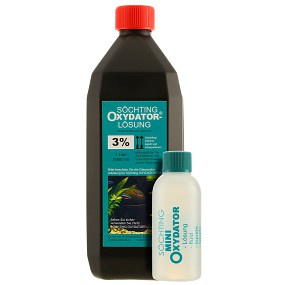In order to get answers to basic questions all around algae in the aquarium, we recommend you read this article first.
If your aquarium is infested with stubborn green algae, for example, or blue-green algae, we highly recommend treating the entire tank with hydrogen peroxide (H2O2). Such a treatment should always be considered the last resort, and it should only be applied when the standard methods have failed and you're about to just give up on your aquarium because you cannot get rid of the algae. Use a dosage as high as necessary and as low as possible in order to spare the animals in your tank undue stress. Certain plants like Riccardia sp. (coral moss) or Riccia fluitans (liverwort) may be damaged in the course of this treatment. Some other aquatic plants may turn a lighter color temporarily, but this is not necessarily a sign that the plant is dead.

Dosage
As a basis for this treatment, we use the 3% solution for the Söchting Oxydator. Please make absolutely sure you do not exceed the percentage of H2O2-of 3% or you may have a hard time calculating the dosages correctly.
Depending on the algae species, we recommend different dosages:
- In the case of blue-green algae: 8 to a maximum of 15 ml of the 3% solution of hydrogen peroxide per 50 liters of water.
- In the case of green algae: 25 to a maximum of 35 ml of the 3% solution of hydrogen peroxide per 50 liters of water.
In order to calculate the dosage you need for your aquarium, divide the gross volume of your tank by 50. Multiply the result with the lowest recommended dosage for the 3% solution of hydrogen peroxide (which depends on the kind of algae you are fighting). Let us give you an example: Let's assume you have a tank with a volume of 300 liters, which is infested with blue-green algae. The calculation you need to make is 300/50*8=48. You will need 48 ml of H2O2 for a treatment in this exemplary tank.
How to proceed
The amount of hydrogen peroxide you have found out in the calculation above is added to the algae-infested tank three to four days in a row. Try to spread the solution as evenly as possible, ideally add it to areas with a good current to avoid local overdosing. Please make sure you do not hit any plants or animals directly with the solution. You will notice many tiny bubbles that form in your tank after the addition of hydrogen peroxide - this is normal and no reason to worry. These bubbles consist of pure oxygen, they are harmless.
After these days have elapsed, please give your aquarium some time to rest. Especially blue-green algae respond quite fast to this treatment, green algae may need some days until they die off. Then the green algae start losing their color and turn lighter and lighter. When the treatment is finished, change at least 50% of the aquarium water. As we cannot totally rule out that beneficial bacteria are compromised by hydrogen peroxide we recommend adding an efficient bacteria starter after the water change to help the beneficial bacteria to repopulate your tank quickly, for example ATM Colony Freshwater or Microbe-Lift Special Blend.
Combination
In especially extreme cases you can combine hydrogen peroxide with Easy Carbo. Of course, the two solutions must not be mixed; please use them separately. When adding Easy Carbo, keep to the maximum dosage recommended by the manufacturer (2 ml per 50 liters). If necessary, increase the dosage slowly and in small steps (to a maximum of 4 ml per 50 liters). The simultaneous use of H2O2 and Easy Carbo has the advantage that the oxygen depletion that may be caused by Easy Carbo is more than leveled out by the oxygen produced by the hydrogen peroxide. The combined use of both algicides increases their effectiveness considerably.
Disclaimer
Please read the safety instructions of each product before use. Avoid direct contact with skin, eyes and clothing, as well as direct contact with animals or aquatic plants. We recommend the use of protective gear (goggles, gloves). Use at your own risk! We do not assume any responsibility for damages that may result from this treatment.